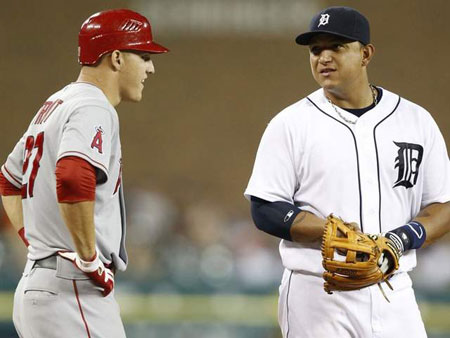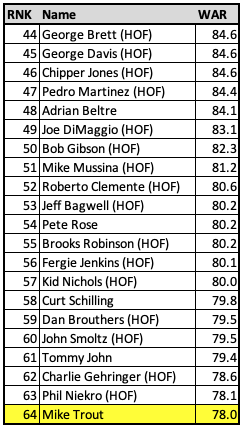Baseball Milestones Set to Fall in 2022

Following the Jeopardy! format in which the answer is given and the question produced, I will use my prophetic predicting skills to pinpoint the precise dates that two notable events will occur this year, along with a bonus Mike Trout prediction. Mark these on your calendar.
Answer: Sunday, April 24, versus the Colorado Rockies
Question: On what day will Miguel Cabrera get his 3,000th career hit?
Miguel Cabrera came into the season with 2,987 hits, which was tied for 33rd all-time with Sam Rice, an outfielder who primarily played with the Washington Senators from 1915 to 1933. Cabrera has since added four more knocks, to pull into 33rd place all by himself. Next up is hit number 3000, which will tie him with Roberto Clemente and put him in an exclusive club that includes many of the greatest hitters of all time. How exclusive is the 3000 Hits Club? Let’s compare it to a few other clubs with nice, round numbers that are meaningful to baseball fans and historians.
3000 Hits—32 players
500 Home Runs—28 players
11000 Plate Appearances—39
1700 Runs Scored—27
1700 RBI—27
When Miguel Cabrera gets his 3000th hit on my predicted day of April 24, he’ll become a member of all but one of these clubs, as he has yet to reach 1700 runs scored. Only six players in baseball history have done this before him. Through Wednesday, April 13, he had 502 homers, 1807 RBI, and 11013 plate appearances. The other six:
13940 PA, 3771 H, 755 HR, 2297 RBI—Hank Aaron
12699 PA, 3304 H, 680 HR, 2151 RBI—Albert Pujols
12493 PA, 3283 H, 660 HR, 1903 RBI—Willie Mays
12817 PA, 3255 H, 504 HR, 1917 RBI—Eddie Murray
12207 PA, 3115 H, 696 HR, 2086 RBI—Alex Rodriguez
12046 PA, 3020 H, 569 HR, 1835 RBI—Rafael Palmeiro
Of the 32 previous 3000th hits, 19 have been singles, 8 have been doubles, 2 have been triples (Paul Molitor, Ichiro), and 3 have been homers (Wade Boggs, Alex Rodriguez, Derek Jeter). I’m predicting a line drive single to right for Miguel Cabrera’s 3000th hit.
Cabrera is projected to get 115 more hits by the FanGraphs Depth Charts. If he reaches that projection, he’ll finish the year with 3106 hits, which would land him in 24th place. Along the way, he will have passed Roberto Clemente (3000 hits), Al Kaline (3007), Wade Boggs (3010), Rafael Palmeiro (3020), Lou Brock (3023), Rod Carew (3053), Rickey Henderson (3055), Craig Biggio (3060), and Ichiro (3089). Also within reach this year are Dave Winfield (3110) and Alex Rodriguez (3115).
Should he hit the 15 home runs he’s projected for, he’ll move into 23rd place and will have passed Eddie Murray (504 homers), Gary Sheffield (509), Mel Ott (511), and both Eddie Mathews and Ernie Banks (512). Willie McCovey, Frank Thomas, and Ted Williams are next on the list, all three tied at 521 dingers.
Answer: Friday, September 30, versus the Oakland Athletics
Question: On what day will Nelson Cruz hit his 30th home run to break the single-season home run record for a player 41 or older?
Ted Williams famously hit a home run in the final at-bat of his career, which was memorialized with a terrific piece of writing by John Updike in The New Yorker that included this paragraph:
Like a feather caught in a vortex, Williams ran around the square of bases at the center of our beseeching screaming. He ran as he always ran out home runs—hurriedly, unsmiling, head down, as if our praise were a storm of rain to get out of. He didn’t tip his cap. Though we thumped, wept, and chanted “We want Ted” for minutes after he hid in the dugout, he did not come back. Our noise for some seconds passed beyond excitement into a kind of immense open anguish, a wailing, a cry to be saved. But immortality is nontransferable. The papers said that the other players, and even the umpires on the field, begged him to come out and acknowledge us in some way, but he never had and did not now. Gods do not answer letters.
Williams’ final-at bat came in 1960, his age-41 season, and it was the 29th round-tripper he hit that year. The previous record for home runs in a season by a player 41 or older was 12, by Hank Sauer in 1958. Dave Winfield became only the second player age 41 or older to hit 20 dingers in a season when he hit 21 for the Minnesota Twins in 1993. Barry Bonds hit 26 in his age-41 season and 28 in his age-42 season, then couldn’t find a job in baseball after hitting .276/.480/.565 that year final year. In 2013, Raul Ibanez hit 29 at the age of 41, tying Williams for the most ever by a player that age or older.
Nelson Cruz is projected to hit 31 more home runs this season, which would be record setting. I’m predicting he’ll do it, but with a twist. I envision a trade in July that sends Cruz from the mediocre-at-best Washington Nationals to the playoff-contending Seattle Mariners, a team for which Cruz played four very good seasons from 2015-2018. Cruz will not only set the single-season home run record for a player 41 or older, he’ll do it for the first Mariners team to make the playoffs since 2001.
Answer: 16 Hall of Famers
Question: How many Hall of Fame players will Mike Trout pass in career WAR this season (FanGraphs version)?
Mike Trout is off to a slow start this year. His 142 wRC+ (through Wednesday, April 13) means he’s only been 42 percent better on offense than the average player after league and ballpark effects are accounted for. Jeez, Mike, what’s wrong? I mean, his career mark is 172, which puts him up there between Mickey Mantle (170) and Barry Bonds (173), but a 142 wRC+ is way down with the dregs, guys like Chipper Jones (141), Albert Pujols (141), Harmon Killebrew (142), and Eddie Mathews (143). I kid, of course. Mike Trout has only played a handful of games this year and he’s still awesome. (Editor’s note: As of publishing, Trout’s back up to a 187 wRC+ on the young season.)
It seems, though, that he’s become something of an afterthought. This is likely due in large part to his injury-shortened 2021 season, when he only played in 36 games (but still hit .333/.466/.624, with a 190 wRC+, best in his career). He’s also overshadowed by his teammate, two-way player Shohei Ohtani. For example, the Los Angeles Angels 2022 promotional schedule includes the following:
April 8—Shohei Ohtani Historic Season Bobblehead
April 10—Shohei Ohtani Clear Tote Bag
May 6—Anthony Rendon Shirt
May 10—Shohei Ohtani MVP Bobblehead
May 27—Shohei Ohtani-Wan Kenobi Bobblehead (Star Wars Night)
June 24—Shohei Ohtani Snow Globe (Christmas in June)
July 14—Shohei Ohtani MVP Shirt
July 29—Mike Trout Tank Top
August 13—Shohei Ohtani Hat
September 16—Mike Trout Bobblehead
That’s seven promotions for Shohei Ohtani, two for Mike Trout, and one for Anthony Rendon. Along with Ohtani, there are other, younger, more popular players across baseball who are taking the spotlight from Trout, guys like Vladimir Guerrero Jr. and Fernando Tatis (when healthy) and Juan Soto, who many believe has surpassed Trout as the best hitter in baseball. Personally, I think we should hold off on passing the crown just yet. Maybe check back in October on the “best hitter in baseball” debate.
Despite the relative lack of buzz around Trout, he’s projected for a 7-WAR season per the FanGraphs Depth Charts, which is the second-highest projected WAR of any player in baseball. Only Juan Soto, projected for 7.5 WAR is higher. A 7-WAR season is amazing, it’s MVP-caliber play and should Trout achieve that level, it would actually be the worst full-season WAR of his career. Since making his debut in 2011, Trout has averaged 9 WAR per 150 games. In 89 games across the pandemic-shortened 2020 season and his injury-shortened 2021 season, Trout averaged 8.1 WAR per 150 games.
With 78 WAR, he’s currently 64th all-time in FanGraphs WAR when you include position players and pitchers. Let’s say he has that 7-WAR season. Should he finish the year with 85 WAR, he’ll move up to 44th all-time and pass 20 players, 16 of whom are in the Hall of Fame. The non-Hall of Famers are Adrian Beltre, who should be elected when he’s eligible, Tommy John, Pete Rose, and Curt Schilling. You know the story with Rose and Schilling. The following chart shows the players Trout could pass this season.

The next player Trout will pass is Phil Niekro, the ageless knuckleballer who pitched over 5,400 innings in 24 seasons, including four seasons with more than 300 innings pitched. Three of those seasons came when he was 38, 39, and 40 years old. Trout could pass Niekro within a week or so. By the end of April, he could move beyond Charlie Gehringer, who was nicknamed “The Mechanical Man” because he was like a wind-up toy that you could start on opening day and get season after season of consistency, with a .300-plus batting average, .400-plus on-base percentage, 100-plus runs scored, and 40-plus doubles.
In May, my crystal ball says Trout will pass Tommy John, John Smoltz, Dan Brouthers, and Curt Schilling. That’s three pitchers and Brouthers, who was a first baseman for ten different teams from 1879 to 1904. It wasn’t until four years into his career that Brouthers faced pitchers who were allowed to deliver the ball from above their waist. The practice of allowing hitters to call for high and low pitches was abolished six years into his career. It truly was a different time.
In June, my Magic 8 Ball predicts Trout will pass Kid Nichols, Fergie Jenkins, Brooks Robinson, Pete Rose, Jeff Bagwell, and Roberto Clemente. Nichols’ career overlapped with the aforementioned Dan Brouthers. He pitched from 1890 to 1906, except for a two-year gap in 1902 and 1903 when he was a player-manager in the Western League. He pitched over 400 innings in each of his first five seasons.
When I throw the bones for July and August, I see Trout passing Mike Mussina and Bob Gibson, a pair of pitchers with 521 career wins and nearly 6,000 strikeouts between them, along with the great Joe DiMaggio, who missed three seasons in the heart of his career due to military service and retired after his age-36 season despite still being an above-average player. The actual war probably cost DiMaggio 15 theoretical WAR.
Should all go as the sacred stones foretell, Trout will rifle past five terrific players in September and October, starting with Adrian Beltre, who should be a first-ballot Hall of Famer when he’s eligible. Then comes Pedro Martinez, Chipper Jones, George Davis, and George Brett, all of whom played at least six more seasons than Trout will have played by the end of 2022.
















